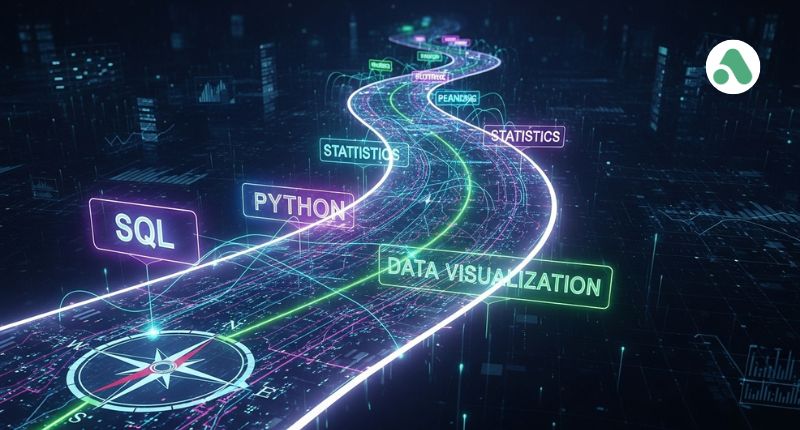Love crunching numbers and solving real-world business problems with data? A career as a Data Analyst might be your perfect next move. Demand for these skills is huge across nearly every industry because companies need people who can turn piles of raw data into smart, profitable decisions—not just guesses. This guide lays out a clear, step-by-step roadmap to get you from the basics to landing your first job. And while it’s written in English, it’s designed specifically as your go-to guide for starting a successful data career here in the Amharic-speaking community.
What Does a Data Analyst Actually Do?
Simply put, a Data Analyst is a company’s detective. Their job is to dive into the business’s information to figure out why things are happening—why sales are up, why customers are leaving, or which products are most popular. They spend their time pulling data from various sources, making sure it’s clean (since data is often messy!), running statistical tests, and then building easy-to-read charts or dashboards. Their final, most important step is explaining their findings to managers and clients so the company can stop guessing and start making informed, smart decisions.
Key Responsibilities:
- Data Collection and Cleaning: Gathering the data and fixing errors or inconsistencies.
- Analysis and Interpretation: Using statistical tests to find meaningful conclusions.
- Visualization: Creating charts, graphs, and dashboards to present findings clearly.
- Reporting: Communicating results and recommendations to stakeholders.
The Must-Have Skills
To actually succeed as an analyst, you need a solid mix of technical know-how and people skills. Focus on mastering these core areas:
Tools & Hard Skills
- SQL: This is non-negotiable. You have to know how to talk to databases—that means pulling, cleaning, and managing data using SQL. It’s the most important technical skill you’ll learn.
- Statistics: You don’t need a Ph.D., but you do need to understand the basics—like averages, medians, and probability—so your conclusions are sound, not just lucky guesses.
- Spreadsheets (Excel/Sheets): Don’t overlook this! It’s essential for quick cleaning, basic calculations, and organizing initial results. Make sure you can rock Pivot Tables and functions like VLOOKUP.
- Python or R: Pick one. These languages are for the heavy lifting: running advanced analysis, building models, and automating the boring stuff. Python is usually the better bet for its flexibility.
- Visualization (Tableau/Power BI): Nobody wants to see a spreadsheet full of numbers. You need to be able to turn your data into clear, compelling charts and dashboards.
Soft Skills
- Communication: This is the most underrated skill. You have to explain complex data stories to non-technical people.
- Problem-Solving: The job is less about running formulas and more about figuring out what questions to ask in the first place, and then designing a plan to answer them.
- Attention to Detail: Messy data gives you bad answers. Being meticulous when cleaning and checking your work is critical for accuracy.
Your Complete Data Analyst Roadmap
You don’t need a four-year degree to land this job, but you do need a solid plan. Here’s a realistic sequence for learning the essentials and getting hired:
Phase 1: Build Your Base
- Master Excel and Basic Stats: Don’t skip this. You’ll use Excel constantly for quick fixes and small projects. At the same time, make sure you understand foundational statistics—things like averages, medians, and what your results actually mean. Khan Academy or a good intro course can help refresh your math.
- SQL is King: This is the most crucial step. Dedicate serious time to learning SQL inside and out. You must be able to pull, clean, and manipulate data from a database. Practice frequently using platforms like LeetCode or HackerRank until it becomes second nature.
Phase 2: Specialize and Visualize
- Pick Your Coding Tool: Choose either Python (focus on libraries like Pandas and NumPy) or R. Commit to one structured course, then immediately start using it on real data.
- Become a Visual Storyteller: Download a tool like Tableau or Power BI. The goal here isn’t just to make a pretty chart; it’s to create a chart that makes a complex idea instantly clear. Practice building interactive dashboards that lead the viewer to a specific conclusion.
Phase 3: Get Hired
- Build Your Portfolio (This is Your Resume): A good portfolio is what gets you interviews. Aim for three solid projects:
- A Data Cleaning Project: Show off your SQL skills by taking a messy public dataset (maybe from Kaggle) and documenting your entire cleaning process.
- An Exploratory Data Analysis (EDA): Pick a topic you love and use your Python or R skills to perform a deep analysis, visualizing the key findings.
- A Professional Dashboard: Create a complete, polished dashboard using Tableau or Power BI.
- Network and Apply: Start talking to analysts on LinkedIn well before you apply. Tailor your resume to highlight the impact of your projects. Practice interviewing—especially the technical SQL and visualization portions. Your portfolio will make you stand out.
Resources and Your Career Outlook
You don’t have to navigate this alone. Here are the best places to learn and what you can expect once you’re certified:
Where to Learn
- Online Courses: Sites like Coursera and edX offer structured, university-quality courses—look for the popular Google Data Analytics Professional Certificate if you want a great entry point.
- Practice and Inspiration: Kaggle is fantastic. Use it to download real-world data, see how other analysts solved problems, and even enter competitions to sharpen your skills.
- Coding Focus: DataCamp is great for getting your coding reps in. It focuses heavily on interactive exercises for Python and R.
- Localize Your Learning: Since most core materials are in English, make sure you use local communities! Connect with data professionals in Addis Ababa or through online Diaspora groups. Discussing complex ideas in your native language can really make things click. Search for Ethiopian or East African data communities online for local networking.
Your Career Outlook
The demand for Data Analysts is huge, not just abroad, but also in fast-growing markets here in East Africa. Once you have this roadmap under your belt, you can find roles in virtually any industry:
- Finance & Banking: Helping predict market shifts and understanding customer spending habits.
- Telecommunications: Finding ways to optimize network speeds and figure out why customers might switch providers.
- Healthcare: Making patient care more efficient and tracking disease patterns.
- Tech Companies: Figuring out what users love (or hate) about an app or website.
After a few years, you won’t just be an analyst anymore. You can step up to a Senior Data Analyst role, move into Business Intelligence, or even specialize as a Data Scientist to tackle bigger modeling projects.








